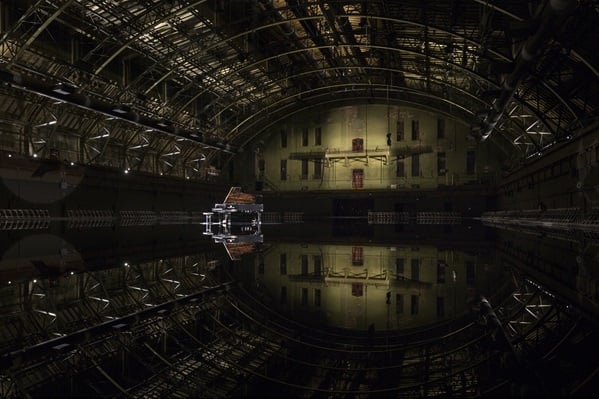Art & Exhibitions
Douglas Gordon at the Armory Is All Flash and No Follow-Through
This Wagnerian wet dream is not a scene from one of Baz Luhrmann’s garish films.

This Wagnerian wet dream is not a scene from one of Baz Luhrmann’s garish films.

Christian Viveros-Fauné

The idea sounds perfectly Gatsbyesque. Build a massive pool inside the 55,000 square foot Wade Thompson Drill Hall of the Park Avenue Armory, fill it with 122,000 gallons of water, perch two grand pianos inside its shimmering reflection, lower the lights and have a young concert pianist in a sexy agnès b costume perform classical versions of watery hits—say, Ravel’s “Jeux d’Eaux” or Debussy’s “Sunken Cathedral.”
This Wagnerian wet dream is not a scene from one of Baz Luhrmann’s garish films, but is instead the premise for tears become… streams become…, Douglas Gordon’s latest over-the-top production at the Park Avenue Armory. Technically a collaboration between Gordon, a Scottish multimedia artist, and Hélène Grimaud, a French classical pianist, the installation continues the Armory’s conspicuous tradition of staging logistically ambitious shows that encourage brand-name cultural figures to realize epic projects. For Gordon, the ambition may have been to walk on water.
Gordon and Grimaud’s monumental work echoes previous musically inspired productions by the Turner Prize–winning artist, including K.364, a film installation based on Mozart’s “Sinfonio Concertante” in E flat, K.364. Yet this new work also mimics the scale of another Gordon collaboration: Zidane: A 21st Century Portrait. A 2006 documentary film the Scotsman made together with French artist Philippe Parreno using 17 synchronized cameras and loads of state-of-the-art equipment, the film captured one of the world’s top athletes plying his trade for 90 grueling minutes. Its effects are mesmerizing. The same unfortunately can’t be said for tears become. Dramatically wan and conceptually undernourished, Gordon’s light and sound installation sinks beneath the weight of the work’s own grandiosity as well as the Armory’s mammoth hall.
A great deal is unknown about tears become. Its title, for one, is in Gordon’s words, an oblique “private reference.” “I once saw a small boy playing the piano with one hand and wiping away tears with the other,” he told the New York Times. “The tears ran down his face and onto his hand and then onto the keys of the piano. It stuck with me, those tears.” Also a mystery is the installation budget. Asking for it produces the usual administrative boilerplate: “As a general policy, the Armory does not disclose project budgets.” This should be unacceptable for a top-flight not-for-profit institution. Because the Park Avenue Armory has become the de facto home for gigantic artworks by artists with interstellar careers—cue blockbusters by Tom Sachs and Paul McCarthy—it is especially important to know what the institution is doing with its money and its tax-exempt status. (While the Armory does publicly report its revenues and expenses, it provides very little information concerning specific projects or how much artists’ galleries contribute to them.)
What is known about Gordon’s aqueous installation is just how complicated it was to put together. His indoor lake required construction workers to prepare the Drill Hall’s uneven floor using laser beams and shims. Several sheets of plastic and pool liner were then laid over that, as well as a layer of particulate board, and 864 cement-bonded panels. Once that was done, water was channeled into the pool through PVC pipes from nine holding tanks. After each performance, mechanical pumps suck up the pool’s four inches of water from the floor shelf, yet thorough cleanup requires manual squeegeeing. Then there are the humidity problems for the Steinway pianos—overcome daily by complex psychrometrics, the field of engineering concerned with water, vapor and air. Finally, there is the elaborate, if underwhelming, light show. In sum, Gordon’s installation is nothing less than a job for the Army Corps of Engineers.
Yet, like so many exhibitions by brand name artists today, tears become is all flash and no follow-through. Typical of the kind of high-end production project that has come to dominate major New York art spaces during our second gilded age, Gordon’s musical number provides much that money can buy, but little of the rupture or synthesis required to make a compelling artwork. This was evident at Gordon and Grimaud’s preview performance. The event featured both figures at the piano bench, with Grimaud playing inspired renditions of Fauré’s Barcarolle No. 5 in F minor, Opus 66 and Berio’s Wasserklavier, and Gordon directing lighting in the darkened Drill Hall. Music soared, lights went on and off and the mind wandered, but not much else happened.
After the artists finished their mini-set—full performances will include another six musical pieces—and sloshed through the pool toward a bright red “Exit” sign, one was left to contemplate something truly spectacular: the breathtaking emptiness of an overblown idea.
Tears become… streams become… will include a series of ten performances by Hélène Grimaud, from December 10 to December 21. At all other times the installation will be open and animated by a digital player piano.
Click here for Christian Viveros-Fauné’s Miami review “Have Art Fairs Destroyed Art? Zombie Abstraction and Dumb Painting Ruled in Miami.”